The sight that all public land turkey hunters want to see: a longbeard sneaking through the timber. John Hafner
In many ways, the wild tom turkey is underrated as a big game animal. He’s got excellent eyesight and hair-trigger instincts that have helped him avoid hunters and spread all across the country. Public land turkey hunting increases the challenge even more. Typically, public land toms gobble less, they frequent fields less regularly, and hang up outside of shotgun range more often. Plus, you’ve got to compete with other turkey hunters who are out hammering the same ground as you.
All of this means that turkey hunting success rates are lower than you might expect. Take my home state of Minnesota for example. We’re covered up with birds and habitat. But the hunter success rate for the spring season hovers around 30 percent. That means two out of three Minnesota turkey hunters are going skunked this spring.
So if you’re planning to hunt turkeys on public land and you don’t want to be among the 70 percent of hunters who will be eating turkey tag soup, then follow this ultimate guide to public land turkey hunting.
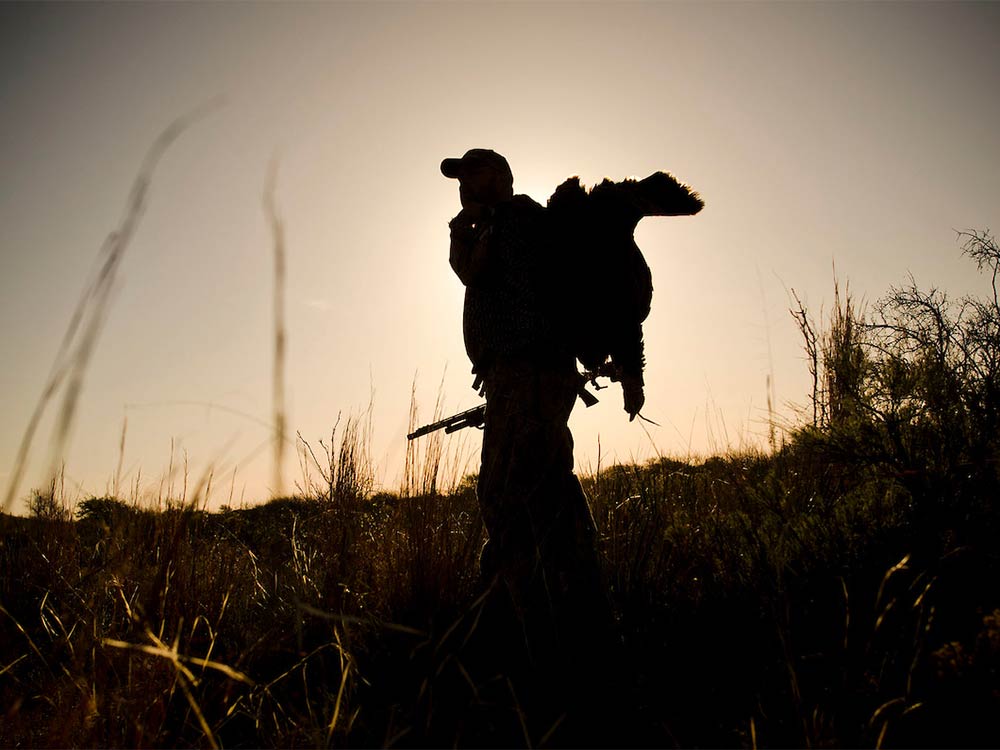
Hike farther from the parking lot to find birds that other hunters aren’t messing with. John Hafner
Where to Find Public Land Near Me?
Finding a good public land hunting spot is the key to success. You want to hunt where the turkeys are and other hunters aren’t. The search begins online. Use a mapping app like onX or Huntstand to identify public lands near you. Also check your state’s public land website (just Google the name of your state and “public hunting land”). Here are some common (and some underrated) land types that often offer public turkey hunting (check local regs before hunting):
- State wildlife management areas
- State forests
- National forests
- Bureau of Land Management land
- National wildlife refuges
- National scenic riverways
- Waterfowl production areas (non-toxic shot only)
- Walk-in access or voluntary public access areas
- Open forest crop
- County-owned forest land
Once you find public land parcels that look promising, it’s time to evaluate each one more thoroughly. Read my full guide on how to scout turkeys here.
Ideally, you’ll find an area that is hard for other hunters to reach. This means areas they are far from a parking lot or road, across a creek or stream, or on the backside of a steep ridge. Check out the screen shot below. This is just what you’re looking for: an hilly hardwoods surrounded by private land and it’s accessible only from the river. Most hunters are not going to go through the trouble of jumping in a kayak or canoe to access this piece of land. And this is precisely what makes these types of places so perfect. (Always double check your local access laws).
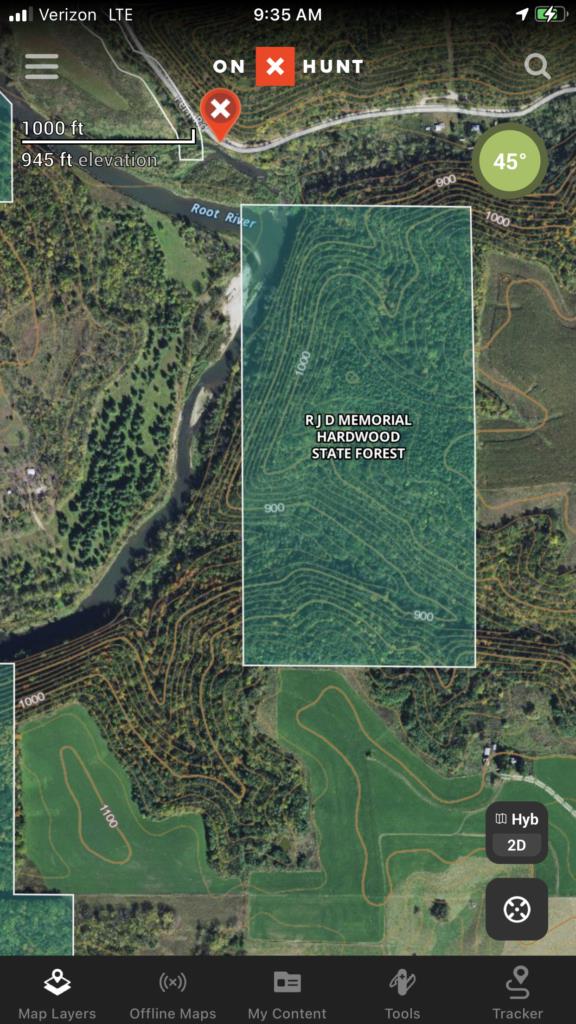
Public land that’s only accessible through water is an ideal place to target turkeys and get away from hunting pressure. onX
Terrain Features and Habitat
Toms love open fields and green meadows where they can display for hens and find feed on bugs or leftover crops. But on public lands, these areas tend to get pounded. Many public land hunters will simply walk to the first field they can get to, set up some decoys, and then spend the morning waiting for a tom to strut in. This is unlikely to work on pressured public lands.
Secluded Hardwoods
Get back into the woods where toms will be spending most of their time. Look for open hardwood flats that are secluded and hard to access. Search for roost sites along the way. Since oaks often hold their leaves longer than other hardwood trees, you can identify stands of oak through the satellite view on digital maps if you sort by month (look at November and December).
Funnels
Turkeys will travel through pinch points in the terrain just like rutting bucks will. This might look like a strip of timber between two waterways, a saddle between two ridge tops, or a flat between a river and a steep hillside. Look for turkey sign in these areas, they’re good places to setup midmorning.
Small Open Areas
Avoid the big, popular fields everyone else is hunting and look for smaller, less obvious openings where toms might want to strut. This could be an intersection of two old logging roads, an abandoned homestead, or an area that was burned or logged the previous season. If you can find one of these spots well off the beaten path, they’ll likely attract turkeys.
Calling and Decoying Public Land Turkeys
Most of the guys I hear in the public turkey woods are not great callers (full disclosure: I’m no Will Primos, either). Luckily, you don’t have to be a great caller to kill a whole bunch of turkeys. If you know you’re not an expert caller (or even if you flat out suck), you can be successful by setting up where the tom wants to be and then giving him some light yelps and clucks. If he likes it, give him a little more. If he doesn’t respond with enthusiasm, then you should stop calling. Curiosity might draw him, but a whole run of crappy calling won’t. When it comes to bad turkey calling, a little goes a long way. If you can’t make even the best turkey mouth call sound like a real hen, then for God’s sake leave it in the truck. A slate call will draw the bird in, and a simple push-button call (which you can run with your shotgun shouldered) will pull him those last few yards into shooting range. When turkey hunting on public land, try to get close to a gobbler (within 200 yards or so depending on how thick the cover is) before calling to him. Most of the time it’s unlikely to call in a bird from a mile away on public land. And getting a turkey to gobble over and over from long range will only draw other hunters to him.
Be ultra careful with turkey decoys on public land. Do not use reaping decoys while hunting turkeys on public ground. Personally, I won’t use a tom decoy on public land either. There are simply too many other hunters around and it’s not worth the risk of them mistaking your decoy for the real thing. I also think that many hunters are too reliant on decoys. You know those videos you’ve seen on hunting TV or Youtube of a big tom strutting in to jump on a turkey decoy at close range? Yeah, that rarely (never?) happens with pressured public land turkeys. I prefer to set up in a spot in the woods where I know turkeys like to be and set out no decoys at all. If I decide to hunt a public land field, I’ll run two or three hen decoys.
Public Land Turkey Hunting Tips
Walk slowly, stop often, listen closely. Far too many hunters bomb through public land scaring turkeys as they go. When you’re moving through areas were turkeys are likely to be, walk as slowly as you can (then slow down even more). Stop and scan for strutters in the distance. Always listen closely for far off gobbles (especially after crows, owls, or coyotes sound off).
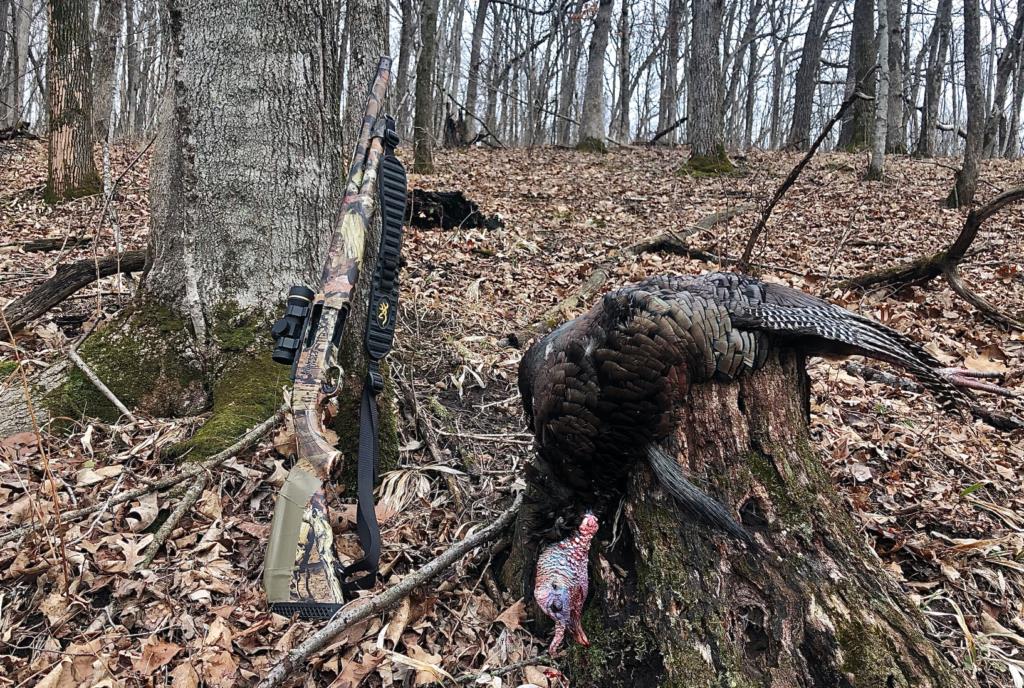
The author’s 2022 public land gobbler, taken in southern Minnesota. Alex Robinson
Hunt mid-morning and midday (if legal). Most other hunters will be out of the woods by then but those gobblers are still out there. Sometimes midday gobblers that have lost or bred their hens are the easiest ones to kill.
Find the roosts. Even though calling a bird right off the roost and into gun range rarely works, it’s still useful to know where gobblers roost. It gives you an idea of where birds will be first thing in the morning and where they’ll be in the evenings.
Talk to the other hunters you meet. If you see other hunters in the parking lot or on the trail, be nice and chat them up. Find out where they intend to hunt and let them know where you’re planning to hunt. It’s far better to work together than compete for the same bird. If you’re both targeting the same birds, consider hunting with each other instead of against each other.
Use trail cameras (if legal). If it’s legal to run trail cameras on the type of public land you’re hunting, you should do it. Just make sure the cameras are in places other hunters are unlikely to stumble into them. And, read our guide on how to use trail cameras for turkey hunting.
Read gobbler behavior. Most of the time public land toms will be sneaky and elusive. They won’t come into your set up gobbling and strutting. These birds take more patience to kill. So if a tom gobbles at one or two of your calls and then goes quiet, don’t be discouraged. There’s a very good chance he’s coming in silently. Give birds like this more time. On the flip side, when you encounter a fired up tom, get aggressive. Call actively and quickly get ready to shoot. This is the bird you’ve been hoping to hear.
Common Public Land Turkey Hunting Mistakes to Avoid
I’ve screwed up my fair share of public land turkey hunts, but I’ve learned from those bone-headed mistakes. If you’re struggling with public land hunts this spring, avoid making the following mistakes:
Don’t Hunt the Obvious Birds
Turkeys that you can hear gobble from the parking lot, birds you can glass from a busy road, birds that roost at the end of a walking trail. Forget ’em. Any public land gobbler that seems too good to be true, probably is. If you were able to find them without much effort, other hunters certainly will too. If you spend your morning setting up on these “easy” birds, you’re almost guaranteed to bump in to other hunters and your enjoyable outing in the woods is going to get frustrating quick. It might seem crazy to pass up turkeys to find turkeys, but you’re much better off hunting birds that other guys aren’t messing with. Just like deer hunting on public land, you’ve got to do a little extra walking to get away from the crowds. Also, you’d be surprised how many turkey hunters won’t cross a creek or a marsh. Wader up and find birds that haven’t been called to yet.
Don’t Stop Scouting During the Season
The most successful waterfowlers spend way more time scouting than they do hunting. When they do commit to a hunt, it’s usually a great shoot. Take a page from their book and sacrifice a couple days of hunting to relocate birds. This is especially useful during midseason when those birds you scouted before the season have been bumped, buggered, or killed. Taking an early-morning drive and hitting as many locations as possible will help you find fresh birds and new spots.
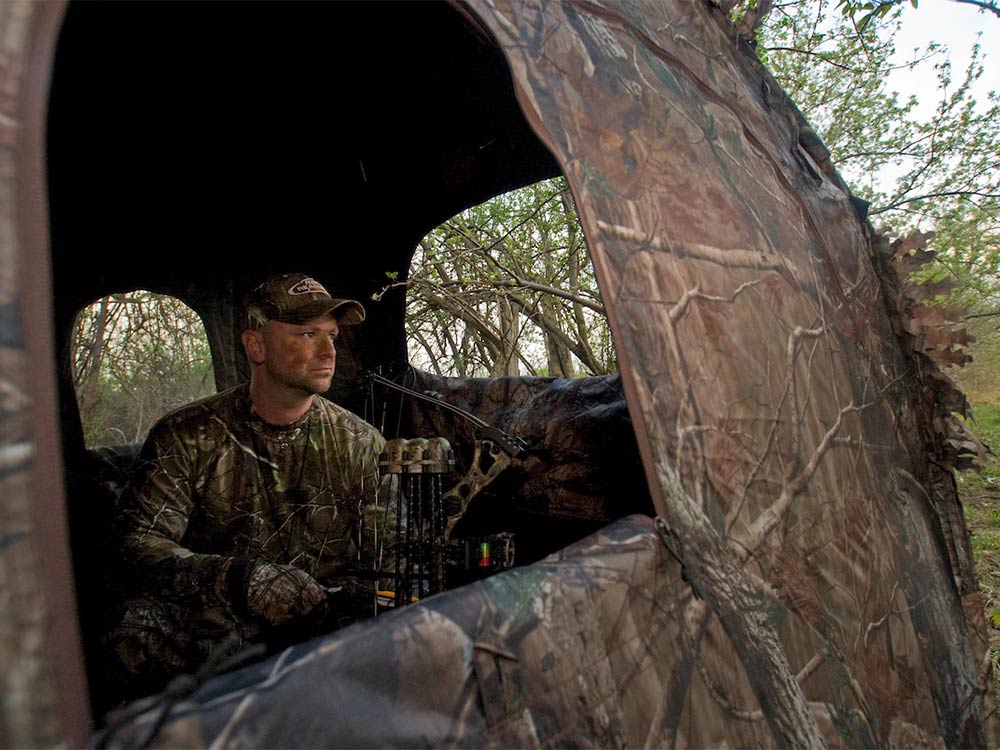
Don’t burn your whole season waiting in a ground blind. John Hafner
Don’t Keep Sitting in the Same Old Blind
I’m amazed at how many hunters will pick a field edge to hunt for the season and just wait… and wait. There’s no doubt that sitting a field edge with decoys can be an effective way to kill turkeys. But on public land, the dynamics are always changing. Your go-to spot can get blown out without you even knowing it. So instead of stubbornly waiting in an area that used to have turkeys, change as the conditions change. Try new, out-of-the-way spots. One of my best public-land spots is a hardwood peninsula that juts out into a big cattail marsh. Gobblers roost in the hardwoods and can’t get off the peninsula without walking by me. The best thing about it is I’ve never seen anyone else hunt it. But, I never would have found that spot if I hadn’t left a more popular piece of public ground to search for new birds.
Don’t Be So Damn Loud
Public land turkeys get blown off roosts. By the second week of the season they know that headlamps and boots tromping through the leaves mean trouble. Sometimes, birds that hear the noisy approach of a hunter won’t blow off the roost right away, but they’ll go quiet. Then they’ll fly down and slip away to safety. Often times the hunter thinks the birds were henned-up and uncooperative. In reality, they were spooked. So on calm, quiet spring mornings, sneak in like a ninja when you plan to hunt near a roost. Leave earlier than you need to, so you don’t have to rush. Leave the blind at home and go as light as possible, so your extraneous gear won’t get caught up in the brush and make a racket. Turn your headlamp well before you get close to the spot. Tiptoe to within 100 yards of the roost and there’s a good chance the gobbler will fly down right in your lap. Legendary turkey hunter Ray Eye once told me a story about a tom in Missouri that he and his buddies just couldn’t seem to kill. After a week of blown attempts, Ray decided to sneak in on the roosted bird at zero dark thirty. He took off his boots when he got close and crept toward the roost tree in his socks, guided only by the light of the moon. Then he waited silently for hours until sunrise. Eventually, the tom flew down and Ray shot him when his feet touched the ground. I’m sure parts of that story have been stretched over the years, but the lesson is a good one: be quiet and get there early.
Don’t Get Discouraged When the Hunting Gets Tough
Sometimes it seems like everybody and their 10-year-old kid has already got their bird. Plus, with all the Facebook and Youtube videos of suicidal toms charging in to decoys, it can be easy to forget that turkey hunting can actually get pretty challenging. So don’t get discouraged when your first couple outings don’t go as planned. Keep changing up your tactics and enjoy those early mornings and late nights, because it’s only a matter of time before that old tom slinks in to range.
How to Get Permission on Private Land
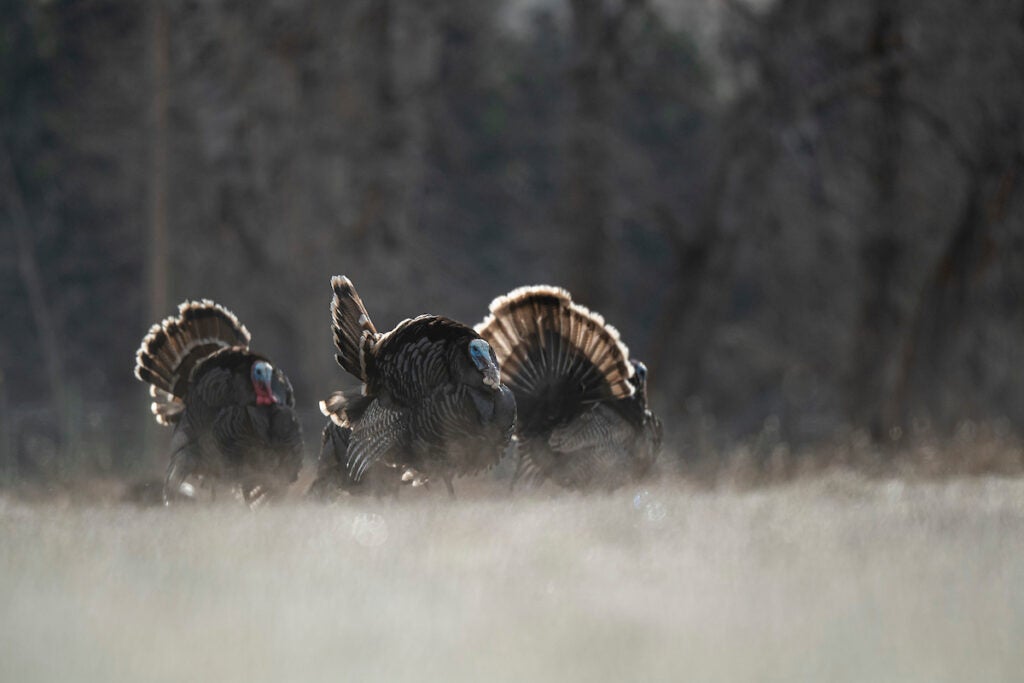
It’s always worth asking permission to hunt on private land. John Hafner
Sometimes it’s nice to have a go-to private land spot if you’re striking out on public ground. Farmers are often more willing to grant permission for turkey hunting than they are for deer hunting, which is a blessing and a curse—because there’s a good chance somebody else already has permission to hunt the place. So start your private land search the same way you’d start your public land search: Use a digital mapping app to locate likely turkey habitat that’s off the beaten path. Look for hardwood ridges near agricultural fields, river bottoms that might hold good roost trees, and timber points that jut out into corn or soybean fields. Mark all your potential new hunting locations and make sure to record the landowners’ addresses.
Then spend a couple afternoons in late winter knocking on doors. Don’t show up during dinner time or on Sunday morning when folks might be getting ready for church. Be friendly and upfront. Tell the landowner you’d like to hunt the place for spring turkeys only, you won’t rut up the fields, you won’t hunt near the cattle, and you won’t have a whole crew of other guys hunting with you. If the landowner declines (no matter what the reason), don’t argue or try to persuade him or her, just say “thanks for the time” and be on your way. Remember: Farmers don’t owe you anything. They’d be letting you hunt their land and not really getting anything in return. Also, local landowners talk to each other. You can earn a reputation in an area quickly, for better or worse.
The post How to Hunt Public Land Turkeys appeared first on Outdoor Life.
Articles may contain affiliate links which enable us to share in the revenue of any purchases made.
By: Alex Robinson
Title: How to Hunt Public Land Turkeys
Sourced From: www.outdoorlife.com/hunting/hunt-public-land-turkeys/
Published Date: Thu, 21 Apr 2022 17:56:50 +0000
----------------------------------------------
Did you miss our previous article...
https://manstuffnews.com/weekend-warriors/college-student-who-ran-over-deer-for-laughs-could-face-jail-time
 Backyard GrillingWeekend WarriorsAdvice from DadBeard GroomingTV Shows for Guys4x4 Off-Road CarsMens FashionSports NewsAncient Archeology World NewsPrivacy PolicyTerms And Conditions
Backyard GrillingWeekend WarriorsAdvice from DadBeard GroomingTV Shows for Guys4x4 Off-Road CarsMens FashionSports NewsAncient Archeology World NewsPrivacy PolicyTerms And Conditions
